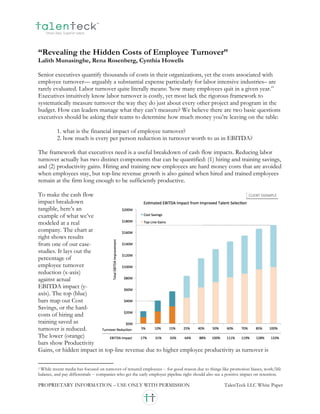
TT White Paper Series - Revealing the Hidden Costs of Turnover
- 1. PROPRIETARY INFORMATION – USE ONLY WITH PERMISSION TalenTeck LLC White Paper alen eck TM Smart data. Superior talent. “Revealing the Hidden Costs of Employee Turnover” Lalith Munasinghe, Rena Rosenberg, Cynthia Howells Senior executives quantify thousands of costs in their organizations, yet the costs associated with employee turnover— arguably a substantial expense particularly for labor intensive industries– are rarely evaluated. Labor turnover quite literally means: ‘how many employees quit in a given year.’1 Executives intuitively know labor turnover is costly, yet most lack the rigorous framework to systematically measure turnover the way they do just about every other project and program in the budget. How can leaders manage what they can’t measure? We believe there are two basic questions executives should be asking their teams to determine how much money you’re leaving on the table: 1. what is the financial impact of employee turnover? 2. how much is every per person reduction in turnover worth to us in EBITDA? The framework that executives need is a useful breakdown of cash flow impacts. Reducing labor turnover actually has two distinct components that can be quantified: (1) hiring and training savings, and (2) productivity gains. Hiring and training new employees are hard money costs that are avoided when employees stay, but top-line revenue growth is also gained when hired and trained employees remain at the firm long enough to be sufficiently productive. To make the cash flow impact breakdown tangible, here’s an example of what we’ve modeled at a real company. The chart at right shows results from one of our case- studies. It lays out the percentage of employee turnover reduction (x-axis) against actual EBITDA impact (y- axis). The top (blue) bars map out Cost Savings, or the hard- costs of hiring and training saved as turnover is reduced. The lower (orange) bars show Productivity Gains, or hidden impact in top-line revenue due to higher employee productivity as turnover is 1 While recent media has focused on turnover of tenured employees -- for good reason due to things like promotion biases, work/life balance, and pay differentials -- companies who get the early employee pipeline right should also see a positive impact on retention.
- 2. PROPRIETARY INFORMATION – USE ONLY WITH PERMISSION TalenTeck LLC White Paper alen eck TM Smart data. Superior talent. reduced. Each full bar represents the total Bottom-Line impact, the addition of the Cost Savings plus Productivity Gains, to the firm at each level of turnover reduction, from existing levels. In this particular example, if there was no turnover at the company, i.e., an absence of turnover or 100% turnover reduction, the y-axis shows the company could add $173 million annually to the bottom-line (far right bar). Those benefits are split: approximately 60% / 40%; where the 60% come from additional employee productivity of $100 million, and the 40% are due to hiring and training savings of $73 million annually. In fact, the estimated total $173 million turnover gains left the table far exceeds the actual EBITDA of this case-study company! Why wouldn’t senior executives want to capture at least a part of that value? Of course, saving all labor turnover costs by entirely eliminating employee turnover is unrealistic. Turnover will never be zero, but even a small reduction yields big benefits. Returning to this example, let’s look at what their executives believed was a more reasonable reduction in turnover. This company’s actual turnover hovers around 75%. A 10% reduction in turnover, from the 75.0% existing turnover to a 67.5%, adds a total of $40 million of the total potential $173 million projected gains. That $40 million is divided into $19 million gained in hiring and training, and $21 million in top-line revenue growth due to higher productivity. The kicker is – the $40 million gain represents more than a 31% increase in EBITDA. Your firm doesn’t have to reduce turnover very far to see enormous benefits. With the right tools, the breakdown of the advantages is elementary. So we have to ask, why wouldn’t a senior executive want to quantify labor turnover to begin reaping these huge gains? To find our more about your company’s labor turnover costs, contact us at www.talenteck.com